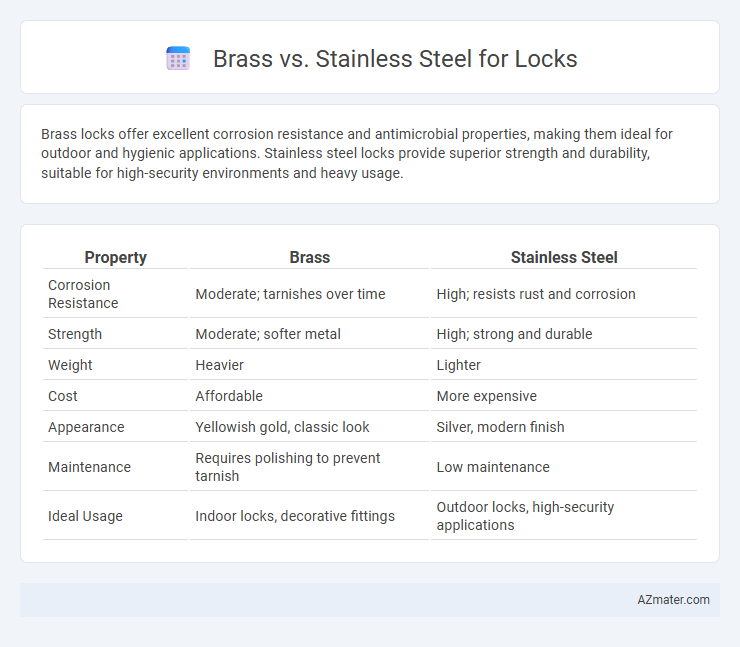Brass locks offer excellent corrosion resistance and antimicrobial properties, making them ideal for outdoor and hygienic applications. Stainless steel locks provide superior strength and durability, suitable for high-security environments and heavy usage.
Table of Comparison
| Property | Brass | Stainless Steel |
|---|---|---|
| Corrosion Resistance | Moderate; tarnishes over time | High; resists rust and corrosion |
| Strength | Moderate; softer metal | High; strong and durable |
| Weight | Heavier | Lighter |
| Cost | Affordable | More expensive |
| Appearance | Yellowish gold, classic look | Silver, modern finish |
| Maintenance | Requires polishing to prevent tarnish | Low maintenance |
| Ideal Usage | Indoor locks, decorative fittings | Outdoor locks, high-security applications |
Introduction: Brass vs Stainless Steel in Lock Manufacturing
Brass and stainless steel are two predominant materials used in lock manufacturing, each offering distinct properties that influence durability and corrosion resistance. Brass, an alloy of copper and zinc, provides excellent machinability and natural antimicrobial characteristics, making it ideal for intricate lock components. Stainless steel, composed primarily of iron, chromium, and nickel, delivers superior strength and resistance to rust and wear, suitable for high-security and outdoor applications.
Material Composition and Properties
Brass locks, primarily composed of copper and zinc, offer excellent corrosion resistance, malleability, and antimicrobial properties, making them ideal for moist and high-contact environments. Stainless steel locks consist mainly of iron, chromium, and nickel, providing superior strength, durability, and resistance to rust and wear under harsh conditions. The choice between brass and stainless steel depends on the environmental exposure, required longevity, and mechanical stress the lock will endure.
Corrosion Resistance Comparison
Stainless steel exhibits superior corrosion resistance compared to brass due to its chromium content, which forms a passive oxide layer protecting against rust and oxidation in humid or salty environments. Brass, composed primarily of copper and zinc, is more prone to tarnishing and dezincification when exposed to moisture and corrosive elements, leading to reduced durability over time. Locks made from stainless steel maintain structural integrity and appearance longer in harsh conditions, making them ideal for outdoor or marine applications.
Strength and Durability Analysis
Brass locks offer excellent corrosion resistance and moderate strength, making them suitable for indoor applications where exposure to harsh elements is minimal. Stainless steel locks provide superior strength and durability, with exceptional resistance to rust and wear, ideal for outdoor and high-security uses. The choice between brass and stainless steel depends on environmental exposure and required security level, as stainless steel outperforms brass in high-stress and corrosive conditions.
Cost Differences and Affordability
Brass locks typically cost more upfront due to their corrosion resistance, durability, and attractive finish, making them a preferred choice for premium security applications. Stainless steel locks, while often more affordable, offer excellent strength and resistance to rust, providing a budget-friendly option without compromising functionality. Choosing between brass and stainless steel locks depends on balancing initial investment with long-term durability and environmental exposure.
Security Features and Performance
Brass locks offer excellent corrosion resistance and antimicrobial properties, making them ideal for outdoor or humid environments while providing moderate security due to their softer metal composition. Stainless steel locks deliver superior strength and durability against physical attacks and rust, enhancing security performance in high-risk settings. Both materials support precision machining for secure locking mechanisms, but stainless steel's hardness ensures longer-lasting resistance to tampering and wear.
Maintenance and Longevity
Brass locks exhibit excellent corrosion resistance and develop a protective patina over time, reducing maintenance needs and ensuring long-term durability, especially in humid environments. Stainless steel locks offer superior strength and resistance to rust and wear, requiring minimal upkeep while maintaining structural integrity under heavy use. Choosing between brass and stainless steel hinges on balancing aesthetic aging properties with the demand for robust, low-maintenance hardware in various environmental conditions.
Aesthetic Appeal and Finish Options
Brass locks offer a warm, classic aesthetic with rich golden hues that develop a natural patina over time, enhancing vintage or traditional decor styles. Stainless steel locks provide a sleek, modern look characterized by their smooth, reflective surface and high corrosion resistance, ideal for contemporary design. Both materials offer diverse finish options, with brass available in polished, satin, or antique finishes, while stainless steel commonly features brushed, mirror, or matte finishes to suit varying architectural preferences.
Environmental Impact and Sustainability
Brass locks, made primarily from copper and zinc, offer high recyclability and corrosion resistance, making them a sustainable choice with lower environmental impact during production. Stainless steel locks, composed mainly of iron, chromium, and nickel, provide superior durability and corrosion resistance, resulting in extended product lifespan and decreased material waste. Both materials support eco-friendly practices, but brass's natural antimicrobial properties reduce the need for chemical treatments, enhancing its environmental benefits.
Best Applications: Choosing the Right Material for Your Lock
Brass locks excel in residential and decorative applications due to their excellent corrosion resistance and aesthetic warmth, making them ideal for outdoor gates and interior doors. Stainless steel locks offer superior strength and durability, suited for high-security environments such as commercial buildings, industrial facilities, and areas with high exposure to moisture or corrosive elements. Selecting brass ensures ease of machining and cost-effectiveness, while stainless steel provides enhanced rust resistance and longevity in demanding conditions.

Infographic: Brass vs Stainless Steel for Lock
 azmater.com
azmater.com